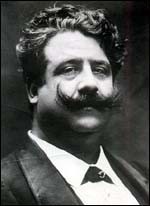| Ruggero LeoncavalloComposerRUGGERO LEONCAVALLOBorn: March 8, 1857, Naples, Italy
Died: August 9, 1919, Montecatini, Italy Italian composer and librettist. Important representative of the verismo movement in Italian opera. Some composers are known for their enormous output in a single genre (Schubert and his songs, for instance) and some are known for their creations in many genres (Mozart is a good example). There are a few composers, however, who have attained great fame on the basis of a single work. Such is the case of Ruggero Leoncavallo and his short opera, Pagliacci. Leoncavallo received his musical education at the conservatory of his native Naples, going from there to Bologna where he received a degree in literature. His first opera, I Medici, was written as the first of a Renaissance trilogy, but it was rejected by his publisher and failed when it finally was staged. His next attempt was Pagliacci, for which he wrote both the libretto and the music. The plot came from a real event—a murder investigated by his father, a police magistrate. This realistic backdrop (one of the important components of the verismo style) sets the stage for a compelling and shocking story of a murder committed in front of an audience as part of a commedia dell‘arte play. The music is equally compelling, and the protagonist‘s aria Vesti la giubba has become one of the most popular tenor arias. Leoncavallo wrote a few moderately successful operas (including a setting of La bohиme, written close on the heels of Puccini‘s), but his fame rests with this one rather short work, which is most often performed paired with another work by a single-hit operatic composer, Pietro Mascagni‘s Cavalleria rusticana (1890). Works: 10 operas, including Pagliacci (The Clowns, 1892), I Medici (1893), La boheme (1897), and Zaza (1900)Other vocal works, including 10 operettas (in French, Italian, and English); songs and choruses, including a RequiemOrchestral works, including a symphonic poem and a balletPiano works, including short character pieces and dancesCopyright © 2002-2007 Norton-Sony Classical | |
 Mariinsky Theatre:
Mariinsky Theatre:  Mariinsky-2 (New Theatre):
Mariinsky-2 (New Theatre):  Mariinsky Concert Hall:
Mariinsky Concert Hall: 

